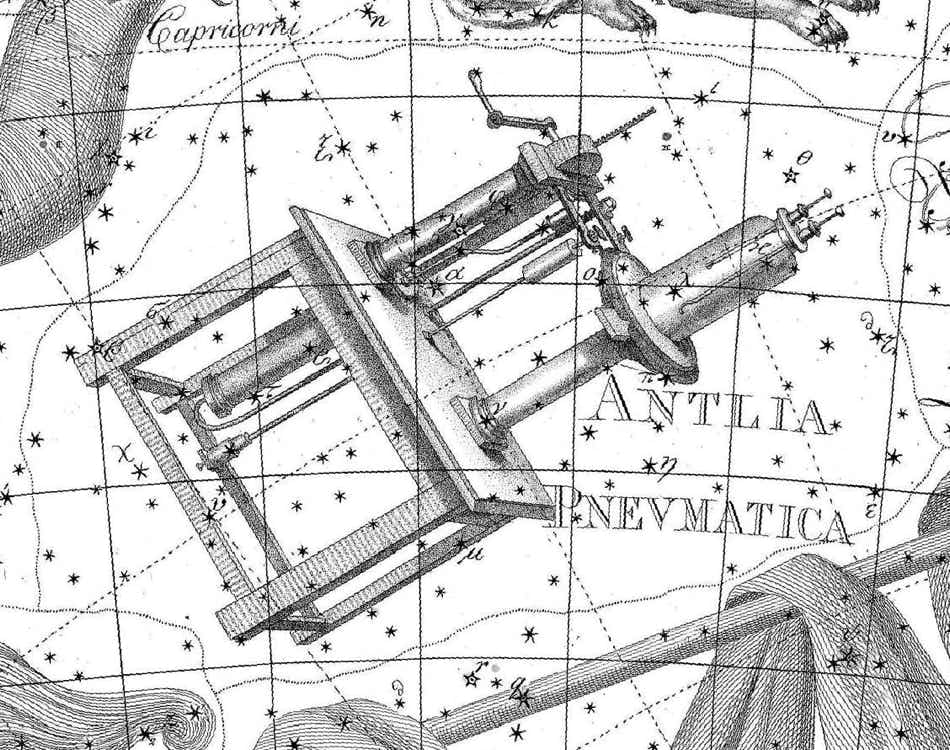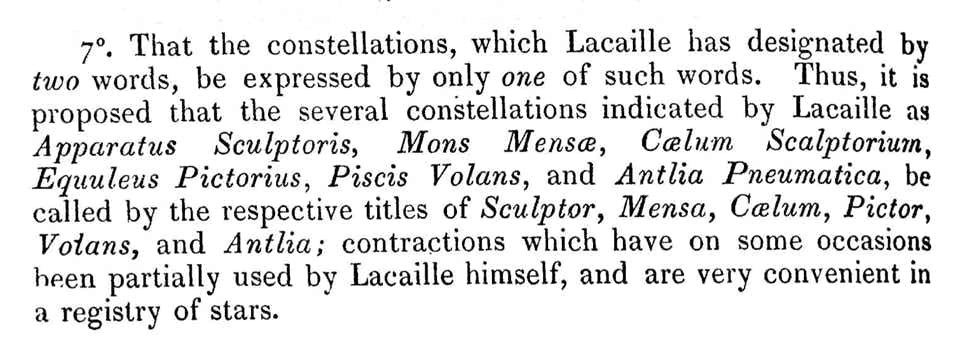
Genitive: Antliae
Abbreviation: Ant
Size ranking: 62nd
Origin: The 14 southern constellations of Nicolas Louis de Lacaille
Antlia is one of the constellations of the southern sky introduced by the French astronomer Nicolas Louis de Lacaille on his map of 1756. He said in the accompanying description that it symbolized experimental physics. Lacaille originally called the constellation la Machine Pneumatique but Latinized this to Antlia Pneumatica on the second edition of the map published in 1763. Following a suggestion by John Herschel, the English astronomer Francis Baily shortened its name to just Antlia in his British Association Catalogue of 1845, and it has been known as that ever since.
Lacaille depicted it as the single-cylinder type of pump used by the French physicist Denis Papin during the early 1670s for his experiments on vacuums, published as Expériences du Vuide in 1674. In 1675 Papin moved from Paris to London where he worked with the Irish physicist Robert Boyle. Here Papin developed the more efficient double-cylinder type of pump, and it is one of these later types of pump that was illustrated by Johann Bode in his Uranographia star atlas of 1801 (below). An air pump of this type is seen in action in the famous painting titled An Experiment on a Bird in the Air Pump by Joseph Wright of Derby (1768).
The air pump shown as a complex piece of apparatus on Chart XIX of the Uranographia of Johann Bode (1801). Compare this version with Lacaille’s simple depiction. Air pumps became scientific toys for the rich during the 18th century. Here, the mast of Argo Navis is seen to the south of Antlia, with the feet of Felis the cat, a now-obsolete invention, visible at the top.
There are no legends associated with Antlia. Its brightest star, Alpha Antliae, is only of fourth magnitude and it contains no objects of note. Its name, however, is one to catch the unwary as it is frequently mis-spelled ‘Antila’.
Chinese associations
Sandwiched between Hydra and Argo, the stars of present-day Antlia were above the horizon of the ancient Greeks but were not incorporated in any of their constellations. Ancient Chinese astronomers lived at a similar latitude to the Greeks, so they too could see its stars and they did make something of them.
One Chinese constellation in this area, Dong’ou, is thought to have incorporated at least two stars of present-day Antlia, one of them being Iota Antliae; two or three other stars of Dong’ou were farther south in Vela. Dong’ou was named after a place in Zhejiang province, on the southeastern coast of China, where barbarians were said to live. Several more stars in western Antlia, including Epsilon, Eta, and Theta, were part of Tianmiao, the celestial temple, most of which lay in Pyxis.
© Ian Ridpath. All rights reserved
Lacaille’s description of Antlia, which he originally called la Machine pneumatique, in Histoire de l’Académie royale des sciences for 1752 (actually published in 1756). He later Latinized the name to Antlia Pneumatica.
John Herschel proposed shortening the names of six of Lacaille’s southern constellations from two words to one in a paper published in the Monthly Notices of the Royal Astronomical Society in 1844. His proposal was readily adopted, and we now know these constellations as simply Antlia, Caelum, Mensa, Pictor, Sculptor, and Volans.





